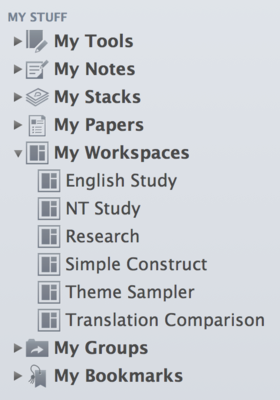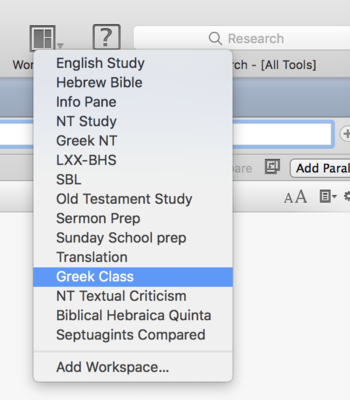
A while back, a user asked me for help in something he was trying to do in Accordance. He opened up his own laptop, launched Accordance, and began with, “This is something I do nearly every day.” Just to get to his question, he first had to build this very elaborate Workspace with multiple texts and reference works. After watching him do this, I said, “Wait—before we get to your question, let me ask you one. Do you create this Workspace every time you use Accordance?” He confirmed that he created this Workspace or one like it most of the time. Moreover, he started each launch of Accordance with his default Search Text. I introduced him to saved Workspaces and he still thanks me for it whenever I see him.
Every Accordance installation comes with five examples Workspaces: English Study, NT Study, Research, Simple Construct, Theme Sampler, and Translation Comparison. You can access these premade Accordance Workspaces from the Workspaces icon in the Toolbar, in the Library Pane under My Stuff: My Workspaces, or File menu: Open Workspace. Any Workspace you create in Accordance doesn’t have to be discarded when you’re through with it. If it’s a Workspace you’re apt to use over and over, consider saving it. The easiest way to do this is to go to the Workspace icon in the Toolbar and select “Add Workspace.” Now your newly saved Workspace will appear under the Workspace icon in the Toolbar and in the My Workspaces folder.

By default, all Workspaces are saved in Documents: Accordance Files on your computer’s main drive. These saved Workspace files will remain unchanged from the first time you saved them, unless you save them again from the File menu. That means you can change them as much as you want, but always start back at the same Workspace, unless you save those changes.
Accordance Bible Software has always been highly customizable. When you customize a specialized Workspace and then save it for repeated use, you’ve also made Accordance quite personal for your use. And saved Workspaces are something you can continue to use long after you finish school.
Bonus tip: Workspaces don’t have to be saved in your Accordance Files folder. I have hundreds of Workspaces saved in folders dedicated to particular projects I was working on at the time. If I need to revisit a particular area of research, not only do I have my notes, I have my Accordance Workspace there, too!
Don’t miss previous installments in our Strategies for Students series!
#1 Take Class Notes in Accordance
#2 Use Accordance Editions of Textbooks
#3 Export Citations from Accordance
#4 Use Accordance for Biblical Language Classes

